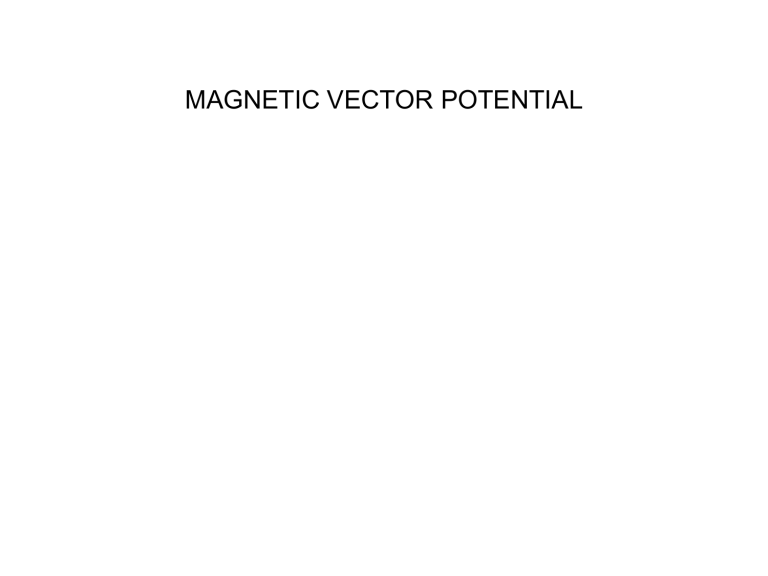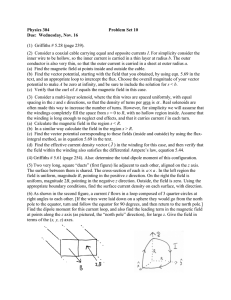3_5-Clickers
advertisement

MAGNETIC VECTOR POTENTIAL Class Activities: Vector Potential One of Maxwell’s equations, Ñ ÑE = 0 made it useful for us to define a scalar potential V, where E = -ÑV Similarly, another one of Maxwell’s equations makes it useful for us to define the vector potential, A. Which one? A) Ñ Ñ E = 0 B) Ñ ÑE = r / e 0 C) Ñ Ñ B = m0 J D) Ñ ÑB = 0 E) something else! E 0 E V Can add a constant ‘c’ to V without changing E (“Gauge freedom”): constant = 0, B 0 B A Can add any vector function ‘a’ with xa=0 to A without changing B (“Gauge freedom”) x (A+a) = x A + x a = x A = B 0 5.25 In Cartesian coordinates, this means: , etc. Does it also mean, in spherical coordinates, that A) Yes B) No 5.25 b m0 A (r ) = 4p òòò J(r') dt ' Â Can you calculate that integral using spherical coordinates? A) Yes, no problem B) Yes, r' can be in spherical, but J still needs to be in Cartesian components C) No. MD12-3 z The vector potential A due to a long straight wire with current I along the z-axis is in the direction parallel to: I A) zˆ B) jˆ (azimuthal) C) sˆ (radial) Assume Coulomb gauge A=? MD12-4a,b A circular wire carries current I in the xy plane. What can you say about the vector potential A at the points shown? At point a, the vector potential A is: A) Zero B) Parallel to x-axis C)Parallel to y-axis D)Parallel to z-axis E) Other/not sure… z b a Assume Coulomb gauge, and A vanishes at infinity y I x At point b, the vector potential A is: A) Zero B) Parallel to x-axis C)Parallel to y-axis D)Parallel to z-axis AFTER you are done with the front side: The left figure shows the B field from a long, fat, uniform wire. What is the physical situation associated with the RIGHT figure? A) A field from a long, fat wire B) A field from a long solenoid pointing to the right C) A field from a long solenoid pointing up the page D) A field from a torus E) Something else/??? 5.27 b Suppose A is azimuthal, given by c A = jˆ (in cylindrical coordinates) s What can you say about curl(A)? A) curl(A) =0 everywhere B) curl(A) = 0 everywhere except at s=0. C) curl(A) is nonzero everywhere D) ??? 5.24 If the arrows represent the vector potential A (note that |A| is the same everywhere), is there a nonzero B in the dashed region? A. Yes B. No C.Need more information to decide What is ò A(r ) · dl A) The current density J B) The magnetic field B C) The magnetic flux B D) It's none of the above, but is something simple and concrete E) It has no particular physical interpretation at all 5.28 When you are done with p. 1: Choose all of the following statements that are boundary conditions B d a 0 implied if Choose for any/all closed surfaces (I) B 0 // // (II) Babove Bbelow (III) Babove Bbelow A) (I) only B) (II) only C) (III) only D) (I) and (II) only E) (I) and (III) only 6.11 I have a boundary sheet, and would like to learn about the change (or continuity!) of B(parallel) across the boundary. B(above) B//(above) Am I going to need to know about A) Ñ ÑB B) Ñ · B C) ??? 5.28 b In general, which of the following are continuous as you move past a boundary? A) A B) Not all of A, just Aperp C) Not all of A, just A// D) Nothing is guaranteed to be continuous regarding A DIPOLES, MULTIPOLES 5.29 The formula from Griffiths for a magnetic dipole at the origin is: m 0 m ´ r̂ A(r) = 4p r 2 Is this the exact vector potential for a flat ring of current with m=Ia, or is it approximate? A) It's exact B) It's exact if |r| > radius of the ring C)It's approximate, valid for large r D)It's approximate, valid for small r 5.30 The leading term in the vector potential multipole expansion involves dl ' ò What is the magnitude of this integral? A) R B) 2 R C) 0 D) Something entirely different/it depends! This is the formula for an ideal magnetic dipole: c B = 3 (2cosq rˆ + sinq qˆ) r What is different in a sketch of a real (physical) magnetic dipole (like, a small current loop)? E-field around electric dipole B-field around magnetic dipole (current loop) From Purcell, Electricity and Magnetism MD12-5 Two magnetic dipoles m1 and m2 (equal in magnitude) are oriented in three different ways. m1 1. 2. 3. m2 Which ways produce a dipole field at large distances? A) None of these B) All three C) 1 only D) 1 and 2 only E) 1 and 3 only MD12-7 The force on a segment of wire L is F = I L´ B A current-carrying wire loop is in a constant magnetic field B = B z_hat as shown. What is the direction of the torque on the loop? A) Zero B) +x C) +y D) +z E) None of these z I(out) B B y x I(in) z I y 6.1 Griffiths argues that the torque on a magnetic dipole in a B field is: t = m´ B How will a small current loop line up if the B field points uniformly up the page? 6.2 Griffiths argues that the force on a magnetic dipole in a B field is: If the dipole m points in the z direction, what can you say about B if I tell you the force is in the x direction? A) B simply points in the x direction B) Bz must depend on x C) Bz must depend on z D) Bx must depend on x E) Bx must depend on z





